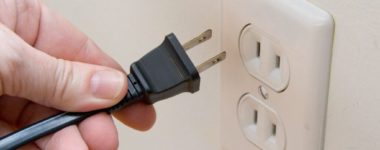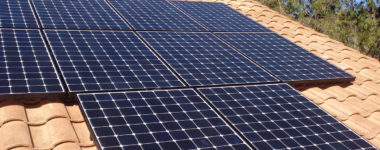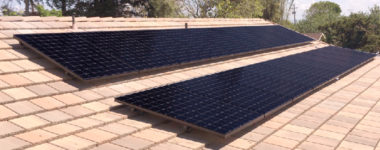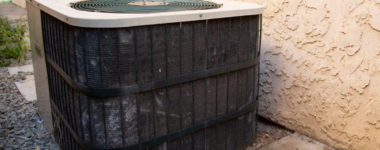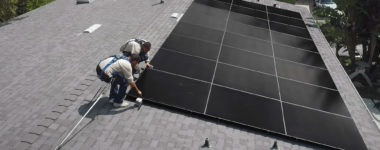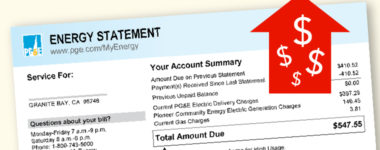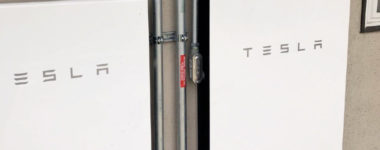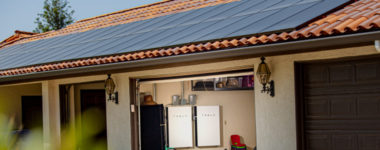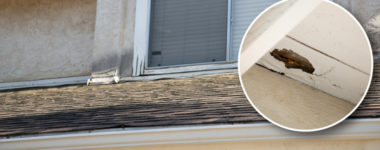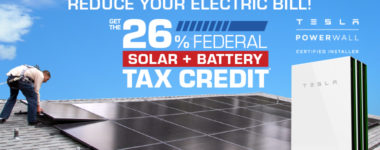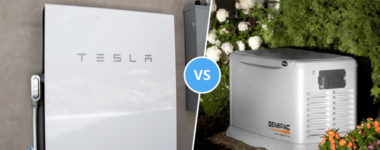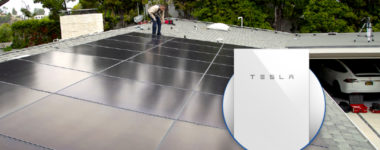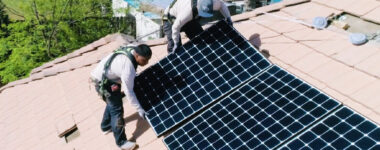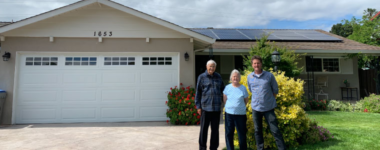Semper Solaris Blog
Does Leaving Things Plugged In Use Electricity? When You Should and Shouldn’t Unplug When was the last time you unplugged your television from the wall? How about your computer, or perhaps kitchen appliances like your toaster or blender? If you can’t remember, you’re not alone. Many Americans have electronic appliances in their homes that remain plugged in 24/7. The potential downside to this is that many electric appliances continue drawing power from wall outlets, even when they’re turned off. The Environmental Protection Agency estimates that in a typical household, 75% of the total power used by consumer electronics is drawn when those items are switched off. In California, where the average household spends about $1,400 per year on energy bills, this waste amounts to an annual cost of around $1,050 (or $88 per month). Knowing when to unplug certain electronics is a simple way to manage your energy consumption and lower your electric bill. What Is Standby Power? “Standby power” is a blanket term that describes the energy used by electronic appliances when they are switched off, or not in use. Some items, in particular, are referred to as “energy vampires” because they require a continuous supply of power to function. Modern consumer electronics offer many convenient features like remote controls and digital displays. These features are popular because they make devices easier to use, but they also increase a household’s standby power consumption. A television set is a prime example of a residential energy vampire because it’s operated by remote control with a receiver. Remote control receivers must remain on at all times to await the activation signal, which in most cases is the power button. The Fight Against Energy Vampires Standby power consumption used to be a largely unheard-of concept, but as more people have become aware of its costs, the collective effort to reduce it has grown and advanced. The 21st century has brought with it new regulations aimed at controlling the standby power consumed by household appliances. Additionally, new technologies like home automation systems can be programmed to cut standby power to appliances when they aren't being used. Other advances in conservation technology can help homeowners save even more on their annual energy costs. Modern home solar panel systems produce clean local energy and are being developed with new features that help reduce waste from standby power even further, such as batteries that can store excess energy for later use. Eliminating Energy Vampires in Your Home The first step to reducing your standby power consumption is to identify the biggest sources of waste in your home. Older appliances are common culprits, as they were designed without standby power consumption in mind. Fortunately, that has changed, and many modern Energy Star appliances are made with standby power requirements that ensure their efficiency. While it can be beneficial to simply replace the older electronics in your home, it can also be very expensive and inconvenient, and may not be the only way for you to conserve. Using automatic timers for your television set, heater, and air conditioner reduces energy waste by cutting standby power to these devices while they aren’t in use, but still allows them to be conveniently ready when needed. If possible, it can also be helpful to replace the older power adapters in your home with newer, lower wattage ones. Adapters are easier and cheaper to replace than appliances but still make an impact on energy consumption. If you have an older adapter that becomes warm when you plug it in, it is likely to use more power than necessary and should be replaced. What Should Get Unplugged? As a general rule, appliances that are remote activated or utilize digital displays tend to consume the most standby power, but not all of these devices can feasibly be unplugged whenever they’re not in use. Computers and cable boxes, for example, have lengthy restarting processes that make it difficult to regularly unplug them. Mobile device chargers: Phone, tablet, and laptop chargers continuously draw power from wall outlets while they’re plugged in, even when the battery is full or there is no device connected. Blu-ray/DVD players: These devices are heavier standby power users because they typically utilize both remote receivers and digital displays. Coffee makers: Many modern kitchen appliances use digital displays that draw standby power but can be easily unplugged when not in use. Microwaves Food processors Blenders Printers: Modern printers often feature advanced digital display screens that consume power while they are in standby mode. While it can be more complicated if you’re using an internet-connected smart printer, you should still unplug printers and fax machines from the wall if you know they won't be in use for a while. What Can Stay Plugged In? Refrigerators: Besides the danger of food spoiling, unplugging your refrigerator is inadvisable because modern refrigerators are designed to be efficiently running all the time, and unplugging won't save you much energy. Wireless modems: While some modems do have digital displays that use standby power, restarting a modem is a tedious process that can interfere with the functionality of other devices in your home. Power Strips and Outlet Control For many people with full schedules and busy lives, it can be difficult to remember every time they leave something plugged in. Power strips are an excellent way to manage standby power use and keep track of all your different appliances. When several devices are plugged into a power strip, you can easily cut standby power to all of those devices at once, just by flicking a switch. Modern smart power strips can even detect when appliances are in standby mode and automatically cut off their power supply.
Global Trends in Renewable and Alternative Energy In 2020, renewable capacity upgrades grew 45% worldwide from 2019, according to a report by the International Energy Agency (IEA) — with a 90% rise in global wind generation and a 23% rise in solar power installations. China alone made up 80% of that rise, with the United States and Vietnam next in line, respectively. Policy deadlines are to thank for the “unprecedented boom.” Another report by the IEA finds that renewables were the only sources of energy to see an increase in 2020, as demand for all other sources declined. Despite supply chain disruptions and construction delays brought on by the COVID-19 pandemic, these sources of energy have remained steadfast. The use of renewables has been dubbed the “new normal” by the IEA. From solar to wind and everything in between, there is no doubt that renewables are the future of energy generation. Countries all over the world are on board with this development, as evidenced by the IEA’s reports. Trends in Solar Energy In 2019, the U.S. Energy Information Administration forecasted that solar energy will be among the fastest-growing sources of electricity generation in the U.S. Solar is a popular alternative energy source — and for good reasons. This energy source does not create pollution or greenhouse gases, unlike its traditional counterparts: coal, oil, and natural gas. Harnessed from the sun’s radiant light and heat, solar power is here to stay. Solar panels, which convert sunlight into electricity, have become efficient, commonplace energy sources for both residents and businesses alike. Other uses of solar power include heating homes, water, and even supplying large power stations. From fighting air pollution to toxic water to homelessness, solar technologies are saving the planet. In 2020, China was leading the way in solar power capacity and was expected to add up to 65 more gigawatts to its grid in 2021. When it comes to the United States, California is the largest producer of solar power in the country. Solar incentives are a driving force to this rise in California, as well as around the world. Trends in Wind Energy The rise in the popularity of wind energy is right up there with solar. In 2020, wind energy capacity nearly doubled from 2019, according to the International Renewable Energy Agency (IRENA) — with China adding 72 additional gigawatts, followed by the U.S. with 14 gigawatts. Once again, China leads the way in wind energy generation with 29% of the world’s share, followed by the U.S. and Germany with 21% and 9%, respectively. There are many benefits of wind energy; it is cost-effective, a clean energy source, sustainable, and creates jobs. Perhaps one of the biggest benefits of wind energy is its ability to ramp up electricity production in cold snaps of weather. This source of energy has its drawbacks too though. One drawback is that wind sites are often located in rural areas, but energy demand largely comes from cities. Transmission lines must be built to carry power to these more densely packed locations, where placing wind turbines isn’t as practical. Besides rural areas, offshore sites are another common location for wind power. In 2021, the U.S. Biden administration kicked off a series of offshore wind projects to foster a clean energy revolution and create jobs. Trends in Hydropower In 2020, hydropower plants contributed to 7.3% of the total electricity generation in the U.S. — and 37% of the total renewable energy generation, according to the U.S. Energy Information Administration. This technology, also known as water power, utilizes mechanical equipment to turn running water into electricity. Hydropower facilities in the U.S. are primarily concentrated in three states: Washington, California, and Oregon. However, this country and those states are not the forerunners of the pack. China and Brazil lead the way in hydropower generation, respectively, with China adding another 6.8 gigawatts to reach over 370 gigawatts of capacity in 2020, according to a status report conducted by the International Hydropower Association (IHA). Citing its low costs and flexibility, the same report by the IHA predicts hydropower will become the dominant source of electricity generation by 2050. Trends in Alternative Fuel Alternative fuel, also known as advanced fuels, is defined as any materials or substances that can be used as fuel, other than traditional sources, such as fossil fuels or nuclear materials. This type of fuel includes gaseous fuels such as hydrogen, natural gas, or propane; alcohols such as ethanol, methanol, and butanol; vegetable and waste-derived oils; and electricity. Biodiesel and bio-alcohol are two of the more commonly known forms of alternative fuel. In 2020, the U.S. and Brazil were leading the way in the production of biofuels, contributing 1,347.3 and 883.7 petajoules that year, respectively. The biofuel revolution in Brazil is largely thanks to Brazilian law, which requires that gasoline be mixed with 27% ethanol. Blending fuel like this releases fewer emissions and contributes to a cleaner environment. What Does This Mean for the Future of Alternative Energy? From solar, wind, and hydropower to alternative fuel, each of these innovations is benefitting our world in myriad ways. For one, the energy that produces zero greenhouse gases is energy that reduces pollution. The environment is not the only thing benefitting from the switch to renewables though. These forms of energy diversify our energy supply, reduce our reliance on imported fuels, and create jobs in manufacturing, installation, and design. The Center for Climate and Energy Solutions (C2ES) reports that renewables have the fastest-growing market of any energy source in the U.S. — from 2000 to 2018, renewable energy witnessed a 100% increase in use. The continued development and implementation of renewable energy sources, however, will heavily rely on the backs of governments all over the world. Policy initiatives and government incentives serve as a driving force to get consumers and businesses alike to make the switch to renewables.
Solar Panels in Sacramento are on the rise! It’s true, Solar has taken over California’s Capital and is turning the City of Trees into the City of Solar! And Semper Solaris is leading that charge! Bringing military-grade service and military-grade values to the Solar installation industry! The City of Sacramento loves Solar power so much it has helped the Golden state reach number one in Solar Installation! Leading the way in California Solar! Best Solar Sacramento That is because California, and Sacramento in particular, believes in Solar power! Whether it be the money saved, the freedom gained, or the sense of pride that comes with sourcing your own energy, the benefits of Solar are overwhelming. Not to mention what it does for the environment! Sacramento Solar Panels 95815 Sacramentan’s can see these benefits clearly, and that is why they are lining up for the amazing state and federal Solar incentives! So, if you are a Sacramento resident, and haven't already gone Solar, make the change now while these incentives last! You’ll reduce your carbon footprint, save thousands, claim your energy independence, and lock in your energy cost forever! That doesn’t just make sense, it’s a no-brainer! And if that isn’t enough to jump on the Sacramento Solar train wait till you hear what Solar is doing for the local economy! The Sacramento Solar boom is boosting the city’s economy at a record pace! Bringing jobs, large-scale commercial projects, as well as federal investment! Best Solar Panels Sacramento With these powerful additions to such a great city, it is plain to see why the City of Sacramento and Solar power are such a great match! Join the Sacramento Solar revolution today!
So, how can you tell if your Air Conditioner needs a repair? Or maybe yet, a replacement. Its April and you are ramping up the use of your trusty AC, however, you are noticing something about it that is needing your attention. You may have come to realize that over the years your AC has already been through several repairs and remarkably, it's still going. The thing is, you might already need to replace it. Here are 5 common signs that you may have to get yourself a new air conditioner: 1. It No longer Cools the Room the Way it Should One of the most telling signs of an AC that is past its prime is that after several repairs, it just is no longer consistent when cooling your room. When you first turn it on, it just blows warm air, and then it takes more than a few minutes to come up with cool air. Even then, it is not as cool as it used to be. For some, it might just be a case of blockage in the duct or maybe a thermostat that needs to be replaced. But if it is something that is regularly occurring then it might be time to replace your AC. 2. It’s Making Some Strange Noises that Doesn't Go Away with Use Grinding, loud squeaking, rattling, and sometimes a little bit of sporadic banging from wherever inside your unit could be signs that wear and tear has already had its way with your AC. A normal operating AC of considerable quality would barely make noise when it runs. But if your unit is getting too loud and is unusually troublesome because of the racket, and, you just had it repaired the previous month. It might do you good to have it replaced eventually. 3. Strange Smells Coming from Your AC An AC that works well should be able to blow cold, crisp, and odorless air from its vent. However, if you smell something strange like a burning or a musty, moldy smell that doesn't go away, it's about time to check your local dealer for a new unit. In fact, something burning could even be an emergency as it needs to be checked immediately. 4. Moisture Build Up One of the conveniences of having an air conditioner is its ability to control humidity, if not eliminate it. This is so that you can enjoy a cool and dry environment where you don't feel sweaty or clammy. An air conditioner that is no longer working properly starts to accumulate moisture right on the unit itself. It sometimes drips out in drops of water, or you might see the front panel "perspiring". Worst case scenario, your unit is already leaking water right inside your room. Fogging windows and moisture in the ducts and vents are also signs of your evaporator coil that is no longer working properly. Mold and mildew can result from these situations and could cause health problems later on. 5. Your HVAC System is Already Old and Needs to Replaced All appliances have their own life expectancy as to when they are able to deliver optimal service right before they expire. In the case of your HVAC system, it should be useful inside of 10 years or more. Naturally, if your air conditioner is already more than 10 years old, even with proper maintenance it will definitely show some signs of aging that could be a combination of any of the first 4 signs discussed above. Anyhow, an older air conditioner even though it may seem okay may already be outdated or obsolete unless it has a lifetime warranty. You could be running higher bills in terms of energy consumption, more than how much you will be paying for a brand new, more energy-efficient, environmentally-friendly unit. The use of Freon (refrigerant) in older ACs has already been phased out, due to its effects on the ozone layer. It was replaced by R-410A (in newer models) which doesn't damage the ozone layer. An air conditioner that still uses freon is already subject to replacement. That goes for older units 10 years and above. The Benefits of Replacing Your Air Conditioner Better Performance No more problems with humidity and irregular cooling patterns. A new unit will deliver consistent cooling power which will keep you comfortable for as long as need it. Savings from Repair Costs If you find yourself paying more in repair costs that are accumulated versus purchasing a new AC, it would make a lot of economic sense to replace it instead. Better Energy Efficiency Newer models mean better technology which then translates to energy savings, all the way to money savings.
Solar panels have been the future of energy for a long time now. They aren't for everyone but they can do a lot of good in the long term. If you're someone who has disposable income and wants to save more on energy as time goes on. Going solar will do a lot of good for you. This also means as time goes on these solar panels are going to go cheaper. Here are 5 reasons why you should switch to solar energy. - Save money on your energy Using solar energy is going to free up the energy costs of making sure that other people have energy. Not only is this good for your community, but you will see yourself saving more and more on your bills because the energy you are using is natural. There is a lot of talk about the kind of energy that we should be using, but it feels like solar energy could be the best in California. Other kinds of energy are getting more expensive. If we get our energy from the sun, that means companies and countries don't have to fight and debate over the energy we should use, saving you money. - California has consistent, warm weather year around While solar energy is good, it's really only optimal in environments where there is a lot of sunshine. Even 93 million miles away, in a snowy town, there will still be solar energy, but it's not optimal at all. In California, there is no real worry about a power outage in the summer with solar panels. California has consistently been sunny and warm meaning that residents will get power as well as their electricity bills going down. For the people who want solar panels for financial reasons, the weather is going to make it a good choice. - Properties with solar panels are seen as more valuable Real Estate seems like it's at an all-time high in California. Living in the state can be expensive, but living in a property with solar panels is going to make paying the monthly bills a lot more attractive to tenants. It's also more valuable because not every person is going to have solar panels in their apartment complex. For people who want to stay indoors during the summer, they will receive massive benefits. If you're a real estate agent, this could potentially make the property more attractive to others. - Renewable energy in the long term As time goes on, there are going to be fewer and fewer fossil fuels for countries to take advantage of. This isn't a problem for our generation, but it could potentially be worrisome for the next generation. Even if they can have enough fossil fuels to last their lifetime, it's going to be a lot more expensive than the money that we paid for those energies. Using solar panels is going to make energy more affordable as time goes on. It's definitely an investment to use them now, but the benefit for the rest of society is definitely there - The government promotes it through policy If you're someone with capital or wealth in California, you definitely dread tax season. However, what you can to get some educations is use solar panels. The government wants to incentivize people to use these panels, so they can get tax breaks if they use them on their private property or business. You get this on top of the benefit for the money you save on your electricity bills. Perhaps, you won't notice these kinds of tax breaks immediately, but as you achieve more and more, you going to pay more attention to these benefits. Conclusion Solar panels aren't for everyone in America, but if you are going to get them, California is a great state for that. The sun is constantly out meaning, you will never have to go weeks without large sources of power. It can easily save you thousands of dollars on energy every year which is only getting more expensive. If you're a real estate agent, solar panels are a great way to attract new customers. And if you're a business, it can get you tax breaks in the state that has some of the highest taxes.
Customers of the utility company Pacific Gas & Electric can expect higher prices in the future and will be seeing their monthly bills go up as a result. Millions of households in California get their utility services from the company and will be directly affected by the 8% average rate increase. The money from the increase will go towards funding improvements in the company's Northern California service area in an attempt to address outdated equipment and cut back on the risk of that equipment sparking another potentially fatal wildfire. The increase will go into effect starting March of this year. This means that residential customers of the company will soon be seeing the results of this rate hike and will be paying an average of $13.44 more monthly when it comes to their gas and electric bills. While it may not seem like much, multiply that by 12 over the course of the year and the average customer will be paying over $150 more annually ($161.28, approximately) for the same services rendered. However, the added cost comes at a time where individuals, couples, and families are struggling already to make ends meet. The Covid-19 pandemic altered economic circumstances for many people. For those who are behind or on the verge of falling behind, the higher bills are yet another financial obligation they must contend with in a situation that is already precarious. Despite what appears to be a quickly-looming date for price increases, the negotiation for the increase itself has been a long time coming. Power regulators in California met with Pacific Gas & Electric and other groups concerned about the financial impact customers might be expected to take on for two years before approving an increase. The utility company's grid provides power to roughly 16 million people in its service area, but the company itself has also been accused of neglect. The out-of-control wildfires of 2017 and 2018 in California were thought to have been caused by outdated PG&E equipment. The wildfires killed over 120 individuals and destroyed more than 27,000 residences and buildings. In 2019, Pacific Gas & Electric filed for bankruptcy. They also negotiated $25.5 billion worth of settlements with those who affected by the fire. It was a real life catastrophe that led to a negative public image and relationship with the public from which the company still has not fully recovered. Now the company has come out of the bankruptcy and is seeking to prevent the same problems that led to those disastrous consequences. The revenue from the rate increase will go to upgrading equipment and implementing new safety measures. While the company is to be lauded for their efforts to increase safety, it also dragged its feet on implementing solutions that were long overdue, and now their customers are literally paying the price. Unfortunately, for those without solar panels or battery storage, relying on a local utility service provider might be their only option and they have no choice but to pay the bigger bills. A solar panel company can install solar panels and battery storage like the Tesla Powerwall easily so that reliance on utilities alone is no longer required. The fact that these panels and battery storage can provide residential power for the home and provides independence is good news as utility rates go up and could increase again in the future. Astonishingly, the rate increase could have been even higher. Regulatory documents show that Pacific Gas & Electric originally proposed the goal of $2 billion more in revenue from increasing customer rates in what would have been from 2020-2022. After negotiations, regulators approved the final rate settlement, which will generate $1.15 billion for the utility company. With wildfire season fast approaching, California will once again be at risk for large wildfires starting and spreading. Pacific Gas & Electric says that it plans to use added revenue to pay for improvements to the grid, trimming trees that are near power lines, and pursuing other actions to decrease the odds of starting another blaze. Some express disappointment with the approval of the rate increase, pointing to the financial strain that the pandemic has caused already. TURN(The Utility Reform Network) worked with other groups to negotiate the settlement of the rate increase with Pacific Gas & Energy. TURN's executive director Mark Toney expressed his concern that higher bills for consumers "will only add" to the problems they have. For now, it appears that customers have no choice in the matter. The rate increase will go into effect on March 1, 2021.
Extreme weather events are inevitable no matter where you live. Recently, the normally mild state of Texas experienced the arrival of a harsh winter storm that brought unusually frigid temperatures, snow, and ice. A power outage only compounded the effects of this cold weather disaster. In California, residents frequently struggle with extreme weather that is opposite to what has been afflicting Texans: dangerous, out-of-control wildfires that lead to extensive power outages. Florida also repeatedly sees vicious storms and hurricanes that wipe out electricity for days on end. During the extreme weather that so many states across the country have been experiencing in the past decade, the importance of having a reliable solar energy storage system is more important than ever. There is nothing quite as dangerous as losing the ability to heat your home in chilling, subzero conditions, or the lack of air conditioning during hot, stifling weather. Independence from conventional power sources is currently one of the few ways to navigate the challenges that power failures bring. This is where the importance of an alternative energy source comes in. Rooftop solar panels and the Tesla Powerwall together serve as a viable solution. The costs of installing an alternative energy system can seem steep at first glance. However, the price is more than worth it when it comes to saving money on electricity and having access to power during an outage. Even during non-emergencies, the ability to reduce an expensive electric bill is always a plus. Solar panels gather energy from the sun throughout the day, while the Tesla Powerwall serves as solar batter storage that you can utilize to accumulate energy for nighttime use or for a time that you truly need it. Depending on the solar panel company, these alternative energy systems can last from anywhere between 10 and 25 years before a replacement is due. Most companies offer 10-year, 25-year, or more warranties just in case of any premature malfunctions. The Tesla Powerwall is an excellent addition to most types of solar energy system, including the Silfab, Q-Cells, Tesla Solar Roof or power system. Powerwalls from Tesla have an energy usage capacity of 13.5 kWh and come with a 10-year warranty. The Tesla Powerwall is also easy to program so that it will automatically switch to stored power during the night or the moment the electricity goes down during a storm. Temperature resilience is another added benefit to these Powerwalls, which makes them suitable for most hot to moderate climates if you choose to install them outside. They function in temperatures as high as 122 degrees Fahrenheit (50 degrees Celsius) and as low as minus 4 degrees Fahrenheit (minus 20 degrees Celsius). Depending on individual homeowners' budgets or household needs, anywhere from one to several installed Powerwalls could be necessary. For the average household, it is better to install two Tesla Powerwalls than one. A single Powerwall restricts energy to minor, low consumption functions such as outlets, power circuits, and lights. A double Powerwall installation is more suitable for most homes so that appliances that take up more energy can also receive enough power to function. With two Powerwalls instead of one, your electricity use can go on as usual during an outage without the need to reduce energy usage to bare necessities. Depending where you live, a snowstorm, hurricane, wildfire, or other unanticipated event of severe weather could kill your power for several days and leave you without running water, heat, or air conditioning. This is not only inconvenient, it is potentially deadly if you are unable to warm or cool your home during extreme temperatures. With the rapidly heating global climate, unusual weather events have continued to increase around the world. The Tesla Powerwall combined with a rooftop solar energy system provides homeowners with a self-sustaining energy source that will keep the lights on during even extended power outages. With sky-high power bills and reoccurring storms or fires, green alternative energy sources can save you a lot of money and inconvenience. While the costs of a solar energy system in addition to a couple of Powerwalls costs several thousand dollars, the price is well worth it when it comes to being able to keep your power on during unavoidable natural disasters.
The expansion of clean energy grows as an innovative solution to energy needs in the United States. Solar panel systems are becoming an energy source that plays a revolutionary role in meeting energy needs, which has fueled their rapid growth in the United States. According to SEIA (Solar Energy Industries Association), the solar market has not stopped growing since it doubled in 2016. Solar battery storage is playing a leading role in the advancement of solar energy. States that promote solar panels and solar battery storage will lead to an unmistakable solar industry trend. What is the last? SEIA has presented an ambitious vision for expanding clean energy in the US to the 117th US Congress. Aware that a new administration will take over in 2021, SEIA recently adjusted its vision for clean energy policies to help solar have at least 20% of generation by 2030 and accelerate the transition to a clean energy economy. SEIA, through one of its directors, announced on October 29, 2020, that Arkansas Group joins the National Solar Trade Association to strengthen solar defense in the southeast. Now the Arkansas Advanced Energy Association (AAEA) is an official state affiliate of SEIA. If you want to be part of this growth, you can participate in SEIA's Solar Goes Corporate. In this forum, buyers and suppliers of clean energy converge, designed to discuss how companies can effectively invest, acquire, and implement clean energy technologies such as solar energy and batteries' storage. The solar energy boom has brought with it the emergence of other renewable technology such as solar batteries capable of storing additional solar energy for later use. In this sense, companies like Tesla develop batteries combined with solar panels to create "solar + storage" systems for domestic and industrial use. Get an informative summary of the basics of solar + storage and SEIA's role by clicking on the following link: Solar + Storage. We invite you to read on to learn more about clean energy and determine if you should consider installing a solar plus storage system for your home. Keep in mind that the cost of solar energy has been falling across the country. Why Choose Solar + Storage? To consider why you may choose to install a Solar + Battery Storage system in your home, you must first understand how a solar PV system like the standard home works. The standard of a solar energy system includes: Solar panels, A kit to mount the panels on your ceiling, An inverter, A performance monitoring system that tracks electricity production. Solar panels concentrate energy from the sun and transform it into electricity, which passes through the inverter and is converted into energy used to power your home. By solar policy, residential solar energy systems must be connected to the electricity grid. This allows the exchange of energy. When your panels make more electricity than your home requires, the excess travels to the power grid. On the contrary, when your solar panels cannot supply your home's electricity demand, you can obtain energy from the electrical grid. Also, by solar polity, you will receive a credit on your electricity bill for helping the utility company by delivering excess power to the grid. Of needing more electricity than your solar panels can generate, you can use those credits instead of paying more for your utility. This process is known as net metering. In all this, the plus is given by the batteries. Solar politics energy storage can smooth electricity prices through arbitrage. It can also mitigate reduction risk, manage nighttime power ramps, provide black start capability, provide backup power, and more. Many solar energy companies like the California Solar Company see storage as a business growth opportunity. They see solar system owners as their allies. This is due to solar politics and to the fact that to achieve 20% of the total electricity generation that the solar industry is targeting, it relies heavily on cost-effective integration of storage. How Is The Storage Of Solar Batteries? The function of solar batteries is to store the energy produced by your solar panels for later use. According to technology, there are solar batteries that come with their inverter and offer integrated energy conversion. The storage is directly proportional; the greater your battery's capacity, the greater its electrical energy storage capacity. At Semper Solaris, a California Solar Panel installation company, they recommend always installing a solar battery as part of your solar panel system, as that allows you to store excess solar electricity in your home rather than send it back to the grid. If your solar panels make much more electricity than required, the excess energy is deposited in the battery. That will decrease the energy exchange with the grid. It will only send electricity to the grid when the battery is 100% charged, and it will only receive electricity from the grid when the battery is low. As you can see, houses with solar energy plus storage will be able to store excess energy for use when in contingency or when the sun doesn’t shine. They have the additional benefit of having short-term backup power in the event of failures in the public service network. Installing A Solar Battery In Your House Is An Opportunity? SEIA is firmly supporting the creation and improvements of an Investment Tax Credit (ITC) for energy storage; it is part of what it has submitted to Congress. Installing a solar battery is synonymous with saving money, which largely depends on solar politics and how the utility company compensates you for your solar energy. With full net metering, you typically receive credits on your electricity bill for every kilowatt-hour of electricity your solar panels produce, so you don't use them right away. However, it may not be so. The trend is for a solar battery to help improve the economy with solar panels for your home or business. Solar battery storage can help you save more, as long as your solar energy supplies your electricity demand. But if the utility company has times of use rates or demand charges or simply does not offer net metering. Not only that, Solar Panels and Battery Storage can help with Sleep Apnea and CPAP Machines even when the electricity goes out. How Does Solar Grid Storage Fit Into The Broader Electrical Ecosystem? Solar batteries and other energy storage technologies are set to become a market of around $ 2.5 billion in the United States by 2020-2021. Why is Energy Storage Expected to Grow so Fast? For the benefits that solar battery storage offer to their owners, such as those of homes, that is: Renewable electricity storage capacity for later use, Ease of application on a larger scale for the entire electrical network. Depending on the technology, they provide more flexibility in the generation and use of electricity, mainly from solar and wind energy. Utilities have a complex task. They need to provide their customers with a reliable and quality service. To do this, they must ensure that they have enough electricity on the grid to meet demand. Otherwise, there can be fluctuations in service and even have dissatisfied customers from experiencing blackouts. For increasing solar battery storage, incentives are needed in that direction. This will help network and utility operators manage their electricity flow operations from renewable resources with more flexibility. In the long term, it means there will be more renewable energy resources built into our nation's electricity mix, where home solar panel systems will be a major stronghold.
A new roof is a crucial home investment - one that shelters your family from the elements, keeps your home insulated, and makes up to 45% percent of your homes curb appeal. This is why you should ensure it is always in pristine condition. If you are not sure whether your roof needs to be replaced or not, our experts can assess and identify whether a roof replacement is necessary for you. If the roof is more than 15 years old, it's wise to get an inspection to determine whether there's any damage to be repaired or if it's time to undertake a whole roof replacement. You don't want to wait for too long to replace your roof as it might begin to accrue water damage and pests and leak in moisture and humidity in your home, which can all lead to more expensive repairs later on. And now that rainy season in California is around the corner, getting a roof replacement can keep your home safe. Here are more reasons roof replacement might be the best solution for your home; To Fix Storm Damage There are a variety of ways in which storms can cause damage, including blowing off weak shingles and causing weaknesses that need a replacement immediately. Shingles that are buckling or curled could signal that you need a new roof. Additionally, high-velocity storms could break tree branches that could break your roof. If the rooftop is in bad shape and can't hold up to some heavy impact, then you may risk getting your home exposed during cold season. Yes, some major repairs can be done, but it's better to opt for a complete roof replacement, especially if your roof has seen better days. Also, check the gutters for shingle granules as a lot of granules could be a sign that your roof is wearing out. Granules help protect the asphalt from the sun, and once they fall off, the quality will deteriorate fast. To Make Your Roof Energy-Efficient Can a new roof reduce your energy costs? Absolutely! Replacing your roof will make your home energy efficient and help you cut down on bills because it puts less strain on your heating and cooling systems. As your roof ages, it becomes less effective in controlling temperatures and humidity, thereby allowing them to seep in and affect your internal environment. Consequently, you are forced to use air conditioners and heaters to regulate the internal environment. There are a few things to keep in mind as a homeowner when determining whether a new roof will cut your energy costs. Energy efficiency varies depending on the material used to build the roof and how it's installed. For instance, your roof should reflect sunlight away rather than absorb heat and transfer it to your home. A new roof that's properly installed should also offer ventilation to ensure lower reliance on the air conditioners. You should also choose roofing products with Energy Star Rating as the shingles are better at reflecting solar back to the atmosphere. That's why you should always work with a professional roofing company to ensure all these things are taken into account. When You Want to Undertake a Major Project Such as Solar Panels Installation To install solar panels on your roofing, the solar roof company will drill into the roof to attach the mounting hardware. That's why, if you are considering going the solar power way, you may need to install a new, long-lasting roof to accommodate solar panels. Keep in mind that solar panels can last for up to 30 years. With this in mind, you should consider installing a roof that won't need to be replaced the roof after 5 or 10 years. Removing and reinstalling the solar panels is labor and cost-intensive. To Increase Property Value Installing a new roof increases your home's curb appeal and value if you want to resell the property. When done in conjunction with fresh paint, it can improve your property value and make it more attractive. Replacing your roof also increases financial security to potential buyers as they won't have to undergo additional expenses on roofing issues. This means your home can fetch good amount in the market. Reach Out to Our Experienced Roofing Experts Today! It's evident that installing a new roof will upgrade your home's efficiency completely and minimize energy bills. A new roof features the latest advances in technology, like high shingle ratings and Energy Star. Water leaks, poor ventilation, and insulation issues can all be solved by replacing the whole roof. You can contact our local roofing company in California to assess your current roof and offer you free estimate on cost of roof replacement. We also offer free estimates on solar panel installation. Do not wait for the rains to begin. Contact us today for a free quote.
The investment tax credit (ITC), also known as the federal tax credit, has encouraged homeowners to purchase and use renewable power like solar. The initiative aims to reduce footprints caused by fossil fuels. According to statistics, burning oil, natural gas, or coal, to use in electricity and heat account for about 75% of the greenhouse gas emission. Greenhouse gas emission contributes to rising global temperatures and the sea level. In turn, this affects climate change. It is no wonder that the US government saw it best to continue with the Solar Investment Tax Credit up to 2022. With the initiative, an average Semper Solaris client will save an estimated $6000**or more when choosing to install solar panels. The cost of solar connection is dropping across the state, making this a suitable time for you to make use of the stem. History of Solar Investment Credit The ITC was founded in 2005 as- the energy policy renewable act of 2005. It was signed into law by President George W. Bush. The initiative was set such that it will expire in 2007. After it was established, the ITC becomes successful in supporting the US transition to renewable energy. Most homeowners took advantage of the Investment Credit to ensure that they have installed the system. Due to the positive effect it had, Congress has extended its expiration various times. The initial reduction was 30%, and it leased through 2019. Donald Trump made the most recent change in December 2020. He extended the ITC at 26%, which was to take effect for the next two years. The goal of extending the solar act over the years is to encourage homeowners to have secure, affordable, and reliable energy. The initiative aims to address the challenges that are found in the US. For that reason, the government has included a tax initiative for the residential properties that are using solar energy. However, when filing for the federal tax credit, you need to understand what it is and what it entails. Your solar PV system installation date was between January 2006 to December 2021. The PV system should be located in your primary residence, or secondary residence, an offsite community solar project. If you are also using electricity, then the electricity used should not exceed the solar system. The solar panels should be owned and not leased. You should be the owner of the home. You need to pay enough taxes to the government so that you can qualify to get 26% of the credit. Keep in mind you will be getting credit and not a rebate. The system you are using should be new or used for the first time. How Does The Tax Credit Work? If you fit the description above, then you will be liable for the solar investment tax credit. In case you find that you do not have enough liability to claim the complete credit in one year, you can choose to roll it over to future years. Keep in mind that you can make a claim as long as the tax credits practical. Keep in mind if you have signed a lease with the solar installer, the system does not belong to you, and if that is the case, you are not legible for the tax credit. For you to receive your credit, you need to complete the IRS form 5685. When filling the taxes, add your information on renewable energy information to your typical 1040 form. Most of the software will have an option where you can file the claim. In case you are using a tax expert ensure you have informed them about the solar energy you are using. In case you pay the same amount as you get for your tax credit, you can pay off the tax debt with the credit you receive. You can also choose to get the remainder after you have withheld the refund. Why You Should Install the Solar Panel In 2021 The ITC has been extended various times over the past years. Although it is an important initiative, at one time it will come to a stop. If so, you need to take advantage of the ITC while it is still active. Going from what has happened in the past, even if the extension is made in the future, it might mean getting a lower tax credit.
Homeowners in California are accustomed to frequent power outages that cause blackouts. What's more irritating is the fact that blackouts tend to remain for a few hours to up to several days. Therefore, homeowners are now looking for portable generators so that they can keep the important appliances running. When it comes to unexpected power outages, people have two options: a backup generator or solar battery storage. However, these days, people are no longer looking for traditional ways. And, there's a good argument that favors adding up a battery backup power in your home. Let's break down the differences so that you can make the right decision. The need for an alternative power source: The main cause of buying a backup power source for your home in almost every part of California is quite understandable. According to the concerned authorities in California, public safety and wildfire aren't likely to perish in the next decade. Hence, power outages tend to be a natural phenomenon in this area. Because of these reasons, the state can encounter power outages for a prolonged time. As such, plenty of electricity consumers both at businesses and homes are going to suffer. In the Southernmost part of the State, the frequent arrival of hurricane style winds has led to more severe consequences about power outages. Even the Northernmost part of California isn't spared. The people in the area experience frequent blackouts during the winter months. Strong winds along with ice storms make the trees to trip over. That way, the trees take down the power lines along with them. All these outcomes compel people to have a backup power solution at their homes or businesses. Hence, a backup generator or solar battery storage can keep the electrical appliances up and running during the blackouts. The traditional way of drawing power from portable generators seem to be absurd in recent years. However, solo solar panels can't provide you the necessary power during the outage. Solar battery backup vs backup generator: As aforementioned, people in California are more accustomed to buying a backup generator for their specific needs. However, things are changing for good. Homeowners tend to opt for a backup generator power source because of two reasons. First, the upfront cost of installing backup generators is pretty much less compared to the other sources for providing backup power. Second, generators are available without problems and they are quite easy to set up as well. In the past, it was an easy affair to get the generator and install it at your home. What's more interesting is that people can find these kinds of power sources at nearby home improvement stores. Some generator models don't even need an expert to install. Despite many advantages, backup generators have many flaws. The first and the most important one of all is that you need to make sure fossil fuels are easy to access. It means fuel should be available during a prolonged electric outage. However, it is seen that arrangement of fuel during this critical period is hard sometimes. That's because people aren't prepared for an outage all the time. Next comes the most important part that people expect, which is noise and compatibility. There is no question that backup generators are big. Also, they make loud, harsh noise while operating. Because of the noise, people find it hard to run the device every day. Now, that means you get benefits from these generators only when there is a major blackout in the area. Finally, the burning of fossil fuels on these generators causes air pollution. Batteries used for energy storage, on the other hand, cost you more upfront. Also, they need a qualified technician to install the same. Apart from these things, batteries solve all the aforementioned issues that are found in traditional backup generators. There are benefits of using battery backup power. First, when batteries are connected with solar panels, they retain the energy. The sun powers the solar panels and the battery refills every day as long as the sun is shining bright. Second, batteries operate without any kind of noise, unlike the backup generators. That way, it favors the people. Finally, there is no emission relating to the utilization of solar battery storage. They operate on a renewable and clean power source, the sun. Energy storage vs backup generators: Verdict Evaluating all the things, it is quite clear that solar battery storage might be the best choice for both your home and office. If you are thinking about making the right decision after comparing both these power sources, energy storage is the best option. Backup generators are indeed quite inexpensive and they can fulfill your power needs. But the benefits of installing battery storage power outweighs them. When you pair them with solar panels, you can save a lot of money on your utility bills. On top of that, battery storage is easy to clean and provides quiet power. Now, these are some of the features you can't expect from an ordinary backup generator. If you are living in California, you are aware of the benefits of getting backup power installed in your living space. Generators have been a popular choice for homeowners for a prolonged time. However, there has been a rise in the population of people who are adopting cleaner, newer battery storage options like Tesla Powerwall or Enphase Encharge Battery. Battery backup provides similar backup power to the conventional generators. But, they don't need fuel to run. All they need is solar panels that capture the sunlight. Battery storage is a cost-effective and eco-friendly method that you can't derive from a traditional generator to draw power. While upfront costs of batteries might be higher, lifelong savings outweighs the upfront payment incurred. Contact Semper Solaris for energy storage solutions all year long: Still, wondering about what might be the better option for your backup power? Don't fret, Semper Solaris can answer your questions. We are a *Tesla Powerwall Certified Installer*. Get an elaborate idea about what solar battery storage is and what they can provide you with. Choose the right solution for your backup power with the best battery storage solutions in California. Now, you can keep the lights on during a power outage.
Technology for storing energy has been around for decades. However, a battery storage unit for solar systems is quite new in the market. Solar batteries can provide economic benefits to homeowners in various ways. Solar power has become more accessible and affordable in the US unlike before. Innovations are helping to solve problems for the consumers that are also impacting the environment. If you have solar panels or are thinking about installing them on your home, it is time that you start thinking about installing battery storage units such as the Tesla Powerwall. There are lots of benefits to it. Continue reading the post to know why you need battery storage with your solar panels. What is a battery storage unit? A battery energy storing unit systems are a set of rechargeable batteries. They store energy from your solar panels. And, provide the energy to meet the requirements both at home or business. Because these units are built with modern technologies, they can store a massive amount of energy produced by sunlight. Battery storage units are capable of providing enough power to your home or office off-grid. Also, they provide backup power when there is an emergency caused by blackouts. Apart from the initial cost of purchasing the unit, they are cost-effective for a longer time. How does the battery storage unit work? Solar battery systems work by storing the excess energy from your solar panels. They can monitor your home electricity usage. The battery system automatically transfers the excess energy to the battery unit instead of sending them to the grid. The battery storage unit distributes the energy when there is a demand in your house. The storage units work by converting the direct current energy produced by the solar panels and stores it as an alternate current for later use. If the battery unit has a higher capacity, it can retain energy more energy from the panels. Solar battery systems work in the following ways. Charging - During the daytime, the battery storage unit gets charged by the energy generated by the solar panels. Optimization - The intuitive software programs installed on the battery storage units make use of algorithms. As such, it coordinates with the solar production, utility structures, usage history, and weather patterns needed to optimize the stored energy. Discharging - The stored energy is discharged from the storing units when there is s need to use. Thus, it helps to eliminate costs when there is demand. Why do you need a battery storage unit? If you install a solar battery system with your solar panels, you can store the excess energy from the sunlight rather than sending it to the power grid. When the panels create more electricity apart from what is needed, the excessive energy helps the battery unit to charge. Energy goes back to the grid after the battery unit is completely charged. And, energy from the grid is drawn when the energy in the storage unit depletes. A battery storage unit is very necessary for some parts of the US where there are heavy blackouts because of certain reasons. Also, you can save a lot on utility bills when you bring home a battery unit. How does a battery energy storage unit save you money? When you install a solar system to power your house without a storage unit, the excess electricity your panels produce goes to the power grid. Solar panels make most of the energy during the daytime when the sun soars higher. However, people need more electricity during the evening hours. But with the battery system installed, you can store the excess energy produced during the daytime is stored on the battery unit. You can use electricity in the evening when the energy costs are higher. The battery stores the energy for you to use it at appropriate hours. That way, it helps you a lot by saving on the utility bills. What is the average lifespan of a solar battery unit? On average, it is seen that a solar battery's life can stay for about 5 to 15 years. Proper maintenance of the electrical equipment can have a drastic effect on longevity. It can even increase the life of the battery energy storage unit. Temperature can have a major impact on solar batteries. So, try to protect it from high temperatures and adverse climatic conditions. Different kinds of solar batteries: Batteries that are used for residential purposes are made with either lead-acid or lithium-ion. Between these two variants, lithium-ion batteries are the best option for your solar panels. However, the other kind of battery is more affordable. Lead-acid battery type - These battery types have a short life along with a low DoD (depth of discharge) compared to other kinds of batteries. Also, they are one of the inexpensive options you can have on the market. If you want to get rid of the power grid and need to install a separate energy system for storage, lead-acid batteries can be your best choice. Lithium-ion battery type - These kinds of batteries are more compact and lighter compared to the lead-acid battery units. They have a longer lifespan n comparison to the lead-acid battery types. Also, they have a higher depth of discharge. But lithium-ion batteries are quite expensive than their counterparts. What is the depth of discharge? DOD or depth of discharge means the battery percentage that gets discharged to the total capacity of the batteries. Take Tesla Powerwall as an example. If you have a unit that holds about 13.5 kWh (kilowatt-hours) of electricity and the discharge is about 13 kWh, the depth of discharge is 96% approximately. When you frequently charge and discharge a battery, the lifespan gets shortened. Many manufacturers specify a recommended DOD for smooth performance. Tesla Powerwall energy storage unit: Tesla Powerwall integrates with your solar panels to store excessive electricity produced during the daytime. It makes the energy available to you when you need it most. This battery unit is weatherproof and requires no maintenance. That's because it is an automated system. Powerwall detects power outages effectively, disconnects from the grid, and becomes the main energy source for your home. All your electric appliances run without interruption. For more information on the Tesla Powerwall and how battery storage can help you, feel free to contact Semper Solaris today.
Fresno County is known as the king of agriculture. The city produces billions of dollars in a variety of crops including tomatoes, oranges, almonds, and grapes. The area ranks number one in the nation when it comes to agriculture. It gets 270+ sunny days each year, and that makes it one of the best places for installing a solar panel system. At present, Fresno has the third-highest number of homes with solar panels. It is the fifth-largest city in the state that has stated embracing solar installation to reduce the energy cost and minimize the carbon footprint on the environment. Also, solar panels can reduce the dependency factors and enable homes to deal with emergencies. Why Should You Go Solar in Fresno? Summer causes a lot of difficulties for people in Fresno. The triple-digit outdoor temperature and increasing monthly bills for indoors make life difficult for many. The residents use more electricity than the national average throughout the year. If you want to minimize you electricity bill, contacting a Fresno solar company to install a solar panel on your roof is a must. After doing so, you will have pay much less for the energy. You can also protect yourself from the increasing electric bills that California is known for. Even if a solar panel offers a lot of benefits, many homeowners still do not consider this option due to the upfront cost. However, you can afford a solar system in the current condition. There are many ways to minimize installation costs. Once you install a solar panel, you can use sunlight to power your home and its many appliances. The kilowatt that your solar system generates is one less kilowatt that you purchase from SCE. You are going to save money every month. At the same time, you are going to contribute to the environment. Let's cover some information in more details. Lower Electricity Bills Installing Tesla Powerwall and solar panel system can enable you to meet the energy needs of your home. It will cut the costs of your utility bills. In Fresno, most households end up paying more than thirty-two percent higher electricity bills than other states. With a solar panel system, you can reduce energy consumption. Currently, thousands of residents are converting to a renewable and affordable energy source, solar panels to find the best alternative for the energy. Incentives & Tax Credits As stated above, you can minimize the installation cost significantly with incentives and tax credits. Many states offer local rebates. In addition to local rebates, you will receive twenty-six percent in federal tax credits. The residents of Fresno might be eligible for SASH. The Single-family Affordable Solar Homes Program of state has been extended to 2021. It offers upfront rebates to all those who cannot afford to install a solar panel. It can be best for low-income homeowners. NEM Program You can also get rebates from the Net Energy Metering program of the state. It works as a driving force to help Fresno residents to install solar panels on their roofs. In 2019 only, 23,300 residents were part of this program. The program will allow homeowners to credit towards their energy bills. Federal Tax Credit The federal tax credit is twenty-six percent of the installation cost. The amount will be deducted from the federal taxes of homeowners. They can claim the credit over many years when the amount is less than their tax credit. However, all cannot be benefited by federal taxes. The federal tax credit can be helpful for all those who pay federal income taxes. If you are paying federal income tax and want to install a solar system, you will have to consider it now. The federal tax credit will be less from 2022 end. It will be twenty-two percent instead of twenty-six percent. So, go solar now in Fresno to get the maximum benefits. Battery Storage A solar panel system will not only reduce your energy cost, but it can also be effective to deal with emergencies. It can power up your home during unpredictable blackouts such as extreme weather conditions. Some natural adversities can cause blackouts for days to millions of people. With a solar system, you can live a normal life and use all your electric devices. Here battery storage comes in. A solar system will not only power up your home during the day hours when the sun is present, but it can also save energy for future use. Solar panels can store the energy in the battery, and you can use it during nights and blackouts. You can get clean energy for eight to twelve years with quality battery storage. The added benefit is that you are not going to pay the TOU rates if you use battery storage for your solar system. How Much Will You Save? The answer will depend on a few factors. The key consideration is the exposure of sunlight to your solar panel. Your solar panel needs to receive ample sunlight to meet the energy needs of your home. When the sunlight will not be adequate, you might not expect the desired benefits. Another factor is the usage of electricity for your home. When some homeowners use more electricity to power their devices, others can manage with less. In brief, the higher power usage will ensure more savings on the energy cost. The average electricity usage in California is around 547 kWh. But you might be spending more if you are using more electric devices. The usage is more in Fresno compared to other parts of California. If you want to know how much exactly you can save by installing a solar panel, you can consider talking to an experienced Fresno solar company. They use a solar panel saving calculator to help the residents of Fresno to know how much exactly they can save on energy bills with a solar system. The calculator can help you to know the number of solar panels you will need for your home.
Originally published May 23rd 2018. Updated January 7th 2021. Good timing is an underappreciated skill that can yield big rewards. Find that perfect seasonal sweet spot, and you can beat the crowds at your favorite vacation destination and save big on hotels and tours. Get to the party right on time, and you can avoid the uncomfortable small talk with the hosts before the other guests arrive. Good timing is everything, so what’s the best time for your solar panel installation in Los Angeles? Is there an ideal time to get solar panels in the lifecycle of your roof? How about the best time to reap as many tax rebates as possible? Or is there an “off-season” for solar that leads to special treatment and big deals? We want to help you and your solar panels in Los Angeles make the perfect entrance. Here’s everything you need to know about when to get your solar panels. The Newer the Roof, the Better Speaking of time, your roof has a finite amount of it. The lifespan of a roof can extend between 20 and 50 years depending on its composition. The majority of roofs in Los Angeles are made of asphalt shingles. While this type of roof is cost-effective, it only offers about 20 years of life. Most forms of tile, another common Southern California roof choice, give you a much longer life of 50 years. Solar panels can last an estimated 25 to 40 years and possibly even longer! (The most current crystalline silicon models of solar panels are still so new, that we aren’t quite sure how long they can really last.) Therefore, if your roof only has about five years left in it, it doesn’t really make sense to install solar panels when you’ll need to take the whole system down again in a few years. Instead, the best time to invest in solar panels in Los Angeles is when your roof is new or has a decade or more of life left. (Is your roof getting close to retirement? Don’t fret! Now might be the perfect time to invest in replacing your roof so that you can get solar panels in the future. A new roof adds value to your home and can make it more energy efficient! At Semper Solaris, we also offer Roof Installations and replacements.) Time Your Tax Relief Currently, homeowners in Los Angeles can deduct 26% of the cost of their solar panels on their taxes. This Investment Tax Credit (ITC) is the biggest renewable energy financial incentive currently available. It saved the average homeowner $5,000 on their solar panel system in 2017. In order to get the tax credit, you just need to install solar panels within the calendar year. The tax credit was originally enacted in 2005 as part of the Energy Policy Act and set to expire at the end of 2007. The federal government extended the ITC, but the clock is running out. Afterwards, the tax credit shrinks each year. Homeowners should not expect the tax credits to be extended again. As the solar market continues to mature and as the government looks for more ways to trim the budget, all signs point to the ITC finally phasing out for good. That means the time to save on solar is right now! The Season for Solar Is there an ideal season to go solar? Angelenos may assume that spring or summer is the best time to put up solar panels. After all, the long summer days mean more sunshine, which translates to more energy production for the year. The truth might surprise you. Winter in Los Angeles is actually the best season for solar. Here’s why: The Slow Season During the winter months, homeowners are often caught up in the holidays and don’t have the extra time, attention, or funds for on solar panels. So use this to your advantage! Solar installation companies usually have fewer jobs on the books during this time of year, which means that they can give you more personalized attention and service. It can also mean a shorter turnaround time on your solar panel installation in Los Angeles, and sometimes special offers and discounts. Easier Installation Your solar installation team will also appreciate your choice to wait until winter for your solar panels. Los Angeles heats up in the summer, with temperatures reaching around 85 degrees toward the end of August. As you can imagine, working all day on a hot roof that absorbs that heat can be pretty uncomfortable for installation teams. On the other hand, winters in Los Angeles are notably mild, which is why we all love living here. Aside from the occasional rain shower, our installation team loves working in the cooler temperatures. Solar Panels Still Work Some homeowners worry that installing solar panels in winter will mean less energy generation. The sun still shines in winter, so your solar panels will work beautifully when they come online. Winter does offer fewer hours of sunlight than summer, so the total amount of energy your panels generate may be less than it would be on the longest day of the year, but the difference is less than you imagine. That’s because of something called the temperature coefficient. Without getting too deep into the weeds, the temperature coefficient describes how well solar panels perform under less-than-ideal circumstances. Many homeowners are surprised to learn that solar panels actually operate better in cooler temperatures. Once the temperature gets hotter than 77 degrees, the efficiency of the solar panels begins to drop. So, even though winter offers fewer hours of sunlight than summer, the cooler temperatures mean that your panels will operate at peak efficiency during light hours. There Really Is No Bad Time to Install Solar Panels in Los Angeles While you may still be wondering about the best time for your solar panel installation, the truth is that the best time to get solar panels is… whatever time is right for you! That may sound a little squishy, but what we mean is that you shouldn’t try to rush your solar panels to get a special tax incentive or hit the solar panel off-season if you aren’t ready. Instead, make sure you have the time, focus, and funds to dedicate to your solar installation so you don’t run into problems or stress yourself out in the process. At Semper Solaris, we will be here when you are ready. We can help you repair or replace your roof to prepare for a solar panel installation in Los Angeles and then perform the installation. We might be a little biased, but we think it’s always a perfect time to invest in renewable solar energy. Contact us to schedule a free energy analysis for your Los Angeles home.
Originally published May 12th, 2019. Updated January 7th, 2021. Currently, solar power ranks high among the fastest-growing markets in the whole world. Thanks to the very high temperatures of the Inland Empire, solar systems are being installed by homeowners at a staggering rate. If you also have at one point considered installing solar panels, you most likely have researched solar panel installation in Inland Empire. However, solar energy installation is a significant investment; thus, you need to distinguish between its real pros and cons just to be sure that you made the right decision. To help you make the best decision, we have put together this guide of the pros and cons of solar in the Inland Empire. Advantages of Solar Energy Little to zero cost of generation For most people in the Inland Empire, the most significant reason for installing solar is that once they are done with the initial cost of installation, the energy is ultimately free. In fact, the only question that you will have in mind is whether the payback period on your initial capital investment will be better compared to the returns you would have got from other investments. Drastically and even totally eliminates energy bills Every single year, home energy costs tend to rise significantly, and the worst part is that there is not much anyone can do about it. Thankfully, by considering solar financing options in the Inland Empire, you can drastically reduce or even entirely eliminate your energy bills. By installing solar in the Inland Empire, you will put a lock in your energy costs for the next 25 years. Environmentally Friendly Although there may be some light emissions during installation and production stage of solar power, they are relatively minimal if you were to compare them with those of generating other energy sources. Widely available geographically Even though there may be those areas that are better suited for solar power compared to others, it still remains an energy option that is still viable in almost all areas. Inland Empire being one of the sunniest parts of California, it even comes out as a perfect area for investing in solar energy. Community Solar helps overcome various installation issues Due to several problems such as insufficient space, there are a few homes that remain unfit for solar energy in the Inland Empire. However, with the introduction of "shared solar," these types of homes can now access solar power by subscribing to "community solar gardens." Apart from helping you generate solar energy without needing to have solar panels installed on your roof, the initial costs are also extremely inexpensive. Low cost of maintenance One of the best things about solar energy is that it comes with the lowest maintenance costs. This is possible because solar energy systems have fewer moving parts, which results in fewer instances of break down. In most cases, all you may need to do is replace your inverter, which you may do only once over the life of your solar system. It is only when you have off-grid systems which generally come with batteries that you may require routine maintenance. You get financial support from the government or state The US Senate in 2020 went ahead to pass an extension to the already 26 percent Renewable Tax Credits. This led to an extension of the tax credit for an additional eight years. Furthermore, there are also rebates that are available in several jurisdictions at the county level, state level, or even utility company level. When you take all the residential solar in the Inland Empire government incentives into account, investing in solar energy also seems a more appealing idea. It improves your home's value According to several studies conducted by the real estate market, those homes that are equipped with a solar power system tend to sell much faster compared to non-solar homes. This is enough evidence to show that equipping your home with solar power significantly increases its value. You become energy independent When you totally depend on your utility company for power, you can go for many hours without electricity in case the grid does go down. However, if you have solar power installed, you will still be able to generate electricity even during emergencies. Disadvantages of Solar Energy Although installing solar power may seem a perfect energy solution up to this point, just like any other thing, it will still come with some cons. Now, let's look at six cons that you should keep in mind before you finally consider going solar: It's quite expensive to get started The initial cost of installing solar energy is the main barrier for most homes in the Inland Empire going the solar way. This is because you will be practically paying upfront for not less than 25 years of uninterrupted energy production. There is no transparency in the solar industry Just like in any other market in the world, there are a couple of good players and many bad ones in the solar industry. While there may be a few excellent installers in the Inland Empire, most of them are just out there to make a profit. At Semper Solaris, we make sure you are given all the options to make the best decision for your home. On top of that, we are there for every step of your solar installation journey. From the first appointment to the permits to turning on your system, we will be there every step of the way. Buying batteries will cost you first, but save you later While most solar systems don't require battery systems like Tesla Powerwall, they will become a must-have if you decide to go with the off the grid option. This means that you will have independent power in case there is an unexpected power outage. Furthermore, these batteries will store any surplus energy produced by your system, which you can sell back to the utility company for more money in your pocket. Requires large space When it comes to determining the amount of power that can be derived from a specific area, we look at power density, which refers to watts per square meter. Generally, solar radiation's global mean power density is about 170 W per m², which is quite high compared to electricity. This means that you will need some substantial amount of space to expertly install enough solar panels to fully power your entire home. It's hard to move house One of the significant shortcomings of solar energy is that it can be quite costly trying to move it when you finally decide to move your home. This can be a disadvantage to the much younger homeowners who may be planning to move in the coming years. But if you decided to keep it on that home, it will bring up the value of the house. Solar panels don't fit all roof types Since most solar systems are installed on roofs, certain roofing materials like cedar tiles can be quite tricky for installers to work on. Additionally, some homes also feature rooftop additions such as roof decks which can also be a hindrance to the installation process. It even becomes worse when your roofs are covered in shades which prevent direct sunlight from reaching them. At Semper Solaris, we have years of experience in many different rooftops. Conclusion Overall, solar energy will help you reduce your overall energy bills, reduce your carbon emissions, and improve your property value. On the other hand, solar power wouldn't be a smart investment if you move a lot, plus the initial costs can be high. Regardless of these, most homeowners believe that the pros of installing a solar system still outweigh the cons as it gives you a peace of mind knowing you won't have to worry about the rising energy bills for over 25 years. If you decide to install solar power in your home, just remember to contact Semper Solaris and speak with one of your representatives.
